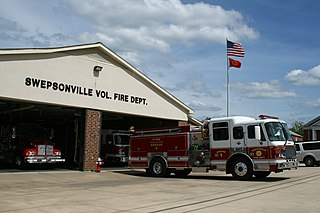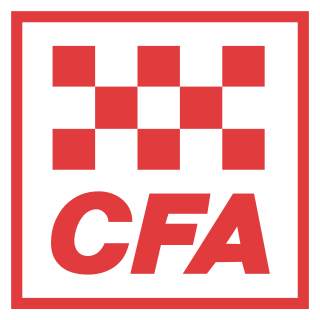
The Boys' Brigade (BB) is an international interdenominational Christian youth organisation, conceived by the Scottish businessman Sir William Alexander Smith to combine drill and fun activities with Christian values. Following its inception in Glasgow in 1883 the BB quickly spread across the United Kingdom, becoming a worldwide organisation by the early 1890s. As of 2018, the Boys' Brigade claimed 750,000 members in 60 countries.

A volunteer fire department (VFD) is a fire department of volunteers who perform fire suppression and other related emergency services for a local jurisdiction. Volunteer and retained (on-call) firefighters are expected to be on call to respond to emergency calls for long periods of time, and are summoned to the fire station when their services are needed. They are also expected to attend other non-emergency duties as well.

The Army Cadet Force (ACF), generally shortened to Army Cadets, is a national youth organisation sponsored by the United Kingdom's Ministry of Defence and the British Army. Along with the Sea Cadet Corps and the Air Training Corps, the ACF make up the Community Cadet Forces. It is a separate organisation from the Combined Cadet Force which provides similar training within principally private schools.

Firefighting is a profession aimed at controlling and extinguishing fire. A person who engages in firefighting is known as a firefighter or fireman. Firefighters typically undergo a high degree of technical training. This involves structural firefighting and wildland firefighting. Specialized training includes aircraft firefighting, shipboard firefighting, aerial firefighting, maritime firefighting, and proximity firefighting.
The Paris Fire Brigade is a French Army unit which serves as the primary fire and rescue service for Paris, the city's inner suburbs and certain sites of national strategic importance.
Firefighting jargon includes a diverse lexicon of both common and idiosyncratic terms. One problem that exists in trying to create a list such as this is that much of the terminology used by a particular department is specifically defined in their particular standing operating procedures, such that two departments may have completely different terms for the same thing. For example, depending on whom one asks, a safety team may be referred to as a standby, a RIT or RIG or RIC, or a FAST. Furthermore, a department may change a definition within its SOP, such that one year it may be RIT, and the next RIG or RIC.

The Country Fire Authority (CFA) is a volunteer fire service responsible for fire suppression, rescues, and response to other accidents and hazards across most of the state Victoria, Australia. CFA comprises over 1,200 brigades organised in 21 districts, and shares responsibility for fire services with Fire Rescue Victoria (FRV), which employs full-time paid firefighters in major urban areas; and Forest Fire Management Victoria (FFMV), which manages fire prevention and suppression on Victoria's public lands. CFA operations and equipment are partly funded by the Victorian Government through its Fire Services Levy, and supplemented by individual brigades' fundraising for vehicles and equipment.

The South Australian Country Fire Service is a volunteer based fire service in the Australian state of South Australia. The CFS has responsibility as the Control Agency for firefighting, rescues and hazardous materials and inland waterways in the country regions of South Australia. Its official mission is "To protect life, property and the environment from fire and other emergencies whilst protecting and supporting our personnel and continuously improving."

The London Fire Brigade (LFB) is the fire and rescue service for London, the capital of the United Kingdom. It was formed by the Metropolitan Fire Brigade Act 1865, under the leadership of superintendent Eyre Massey Shaw. It has 5,992 staff, including 5,096 operational firefighters and officers based at 102 fire stations.
The New Zealand Fire Service was New Zealand's main firefighting body from 1 April 1976 until 1 July 2017 – at which point it was dissolved and incorporated into the new Fire and Emergency New Zealand.
Junior firefighting is a youth activity mostly organized by fire departments. It serves as a means of personal development for the youths, as well as a recruiting pool for the fire departments.
A fire class is a system of categorizing fire with regard to the type of material and fuel for combustion. Class letters are often assigned to the different types of fire, but these differ between territories; there are separate standards for the United States, Europe, and Australia. The fire class is used to determine the types of extinguishing agents that can be used for that category.

Fire fighting in Finland is regulated by the Ministry of the Interior. Municipalities of Finland can choose whether the fire and rescue services are provided by a professional fire brigade, a half-ordinary fire brigade or a voluntary fire brigade. Half-ordinary and voluntary fire brigades rely on non-professional voluntary fire fighters who have been trained appropriately. The main responsibilities of fire brigades are rescuing people, protecting property and the environment, limiting damage and consequences.
As firefighting has a rich history throughout the world, traditions in this profession vary widely from country to country.
The Amabile Choirs of London, Canada is a nonprofit organization with the purpose of bringing together young singers from London, Ontario and surrounding areas. They are "regarded as among the premiere choral ensembles for children and youth," according to The Canadian Encyclopedia, the national encyclopedia of Canada.

Firefighting has historically been a predominantly male profession throughout the world. However, since the 1970s, women have made inroads in both professional and volunteer fire departments in multiple countries. In modern times, women have served in a variety of fire service roles including as fire chiefs. Nonetheless, they comprise less than 20% of firefighters even in the countries where they are best represented.

The Union Internationale de Pentathlon Moderne, commonly known by the acronym UIPM, has been the international governing body of modern pentathlon since its foundation in London in 1948. Its headquarters are in Monte-Carlo, Monaco, and it has 115 national federation members. Modern pentathlon was introduced at the fifth Olympiad in Stockholm, Sweden, in 1912, comprising the contemporary sports of pistol shooting, fencing, swimming, horse riding and running, which embraced the spirit of its ancient counterpart.
There are many national organisations in the United Kingdom that have been established to provide services to people under the age of 18.

The German Youth Fire Brigade is in place to promote an interest in German fire brigades and train young people in preparation for joining. Depending on the German state, the exact name of the programme varies.











